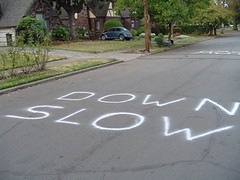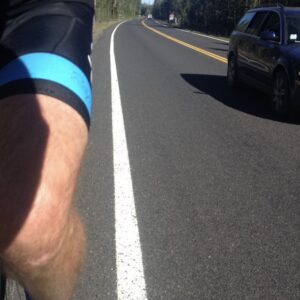
cities to lower speed limits
on residential streets.
(Photo © J. Maus)
House Bill 3150 took a very big step toward becoming reality today. The bill, which would give cities the authority to lower the speed limit on residential streets by five miles per hour (from 25 to 20 mph in most cases), passed a vote on the Senate floor by 26-3.
HB 3150 passed the House by a wide margin back in March and has been working its way through the Senate committee process ever since.
The bill is a top legislative priority of the City of Portland and PBOT Director Tom Miller testified in support of it back in February. HB 3150 initially sought to define the term “neighborhood greenways” but that language has been removed from the bill. Also not in the bill is a proposal by two Republican state senators who wanted raise Oregon’s freeway speed limit to 75 mph.
“We’ve just gained a tool that makes them [neighborhood greenways] great for all users of the road and especially for neighbors who are fighting for lower speeds on their streets.”
— Rob Sadowsky, BTA
Below is the language of the bill as passed by the Senate (full text here):
A road authority may establish by ordinance a designated speed for a highway under the jurisdiction of the road authority that is five miles per hour lower than the statutory speed. The following apply to the authority granted under this subsection:
(a) The highway is located in a residence district.
(b) The statutory speed may be overridden by a designated speed only if:(A) The road authority determines that the highway has an average volume of fewer than 2,000 motor vehicles per day, more than 85 percent of which are traveling less than 30 miles per hour; and
(B) There is a traffic control device on the highway that indicates the presence of pedestrians or bicyclists.(c) The road authority shall post a sign giving notice of the designated speed at each end of the portion of highway where the designated speed is imposed and at such other places on the highway as may be necessary to inform the public. The designated speed shall be effective when signs giving notice of the designated speed are posted.
Rob Sadowsky, the executive director of the Bicycle Transportation Alliance (BTA) says the bill will lead to even better — and safer — neighborhood greenways:
“We’ve just gained a tool that makes them [neighborhood greenways] great for all users of the road and especially for neighbors who are fighting for lower speeds on their streets. We have neighborhood groups who desperately want to lower their speed limits on blocks to 20 mph.”
Since some (minor) changes were made in the Senate, the bill now heads back to the House for a concurrence vote, where it’s expected to pass and then head to the Governor’s desk for signing.





Thanks for reading.
BikePortland has served this community with independent community journalism since 2005. We rely on subscriptions from readers like you to survive. Your financial support is vital in keeping this valuable resource alive and well.
Please subscribe today to strengthen and expand our work.
Absolutely ridiculous. Now I’ll be able to get a speeding ticket heading towards the river on Salmon – ON MY BICYCLE.
Well no specific roads have even been proposed for this yet so even if it passes your statement is not correct, Portland will have to consider each road on an individual basis. However, if you are going enough faster than 20 mph that a police officer would actually ticket you on a neighborhood street then maybe you ought to consider riding on an artery, or slowing down. I don’t really want anyone travelling over 25mph in any vehicle on my street.
Overall though I think the effect this will have will be more to reduce the volume of motor vehicles who are using neighborhood greenways to travel long distances than it will be to force cyclists to slow down. Given the choice between a 20 and a 25 mph street cars will hopefully choose the 25mph option. Diverters would still be nice too though.
What would be ridiculous is that you would get a ticket for speeding riding your bike (I mean,how much are we paying cops to give speeding tickets to cyclists? is this an efficient way to spend money?). Laws to reduce the speed limits in residential neighborhoods are intended to slow down cars which present the real danger to kids crossing or playing kickball in the streets. What is ridiculous is saying a bicycle is the same as a car and must be regulated like a car.
What would be considered “a traffic control device on the highway that indicates the presence of pedestrians or bicyclists”? Are we talking signage, in addition to the speed limit signs? Or does this means sharrows or crosswalk stripes?
That’s a good question. I haven’t seen/heard of an official list, but I assume that could be sharrows, speed bumps, curb extensions, crossing signage, and so on.
https://www.oregonlaws.org/glossary/definition/traffic_control_device
Raising the freeway limit and the highway limit are different animals. I would support the former and oppose the latter.
Still, I’m excited about the possibility of lowering the limit on the street in front of my house.
This is fairly useless. My street (ideally a 15-20 mpg street) connects two 25/35 mph streets and people routinely go 35-40 on it. No police ever patrol it, nor should anyone expect them to.
Take a cue from the folks in Ladd’s Addition. Ask and you shall receive. If enough people on your street ask for a sting you’ll get one.
So there is a sting… once or twice a year? How does that make a difference for the other 363 days a year?
for the other 363 days, you should just install some official looking big yellow SLOW signs
Have an enforcement party: sit with your neighbors on your street, take photos and jot down liscense plates while having fun…won’t hold up in court, but shaming goes a long way!
This does little if there is no enforcement. Why make another law that everyone ignores? (yeah, I’m looking at you Mr. No Cell Phones While Driving Law). Let’s spend less time making new laws and more time enforcing the ones we have.
I think the chances of getting our legislators out on the streets issuing speeding tickets is slim.
Hey! “… legislators out on the streets issuing speeding tickets is slim.” That’s funny!
how do they define a “highway”? seems like that means a freeway, or a road like Powell…
otherwise seems like a good thing… baby steps…
In Oregon it is pretty broad, if you can drive your car on it, it is probably a highway:
https://www.oregonlaws.org/glossary/definition/highway
I think 20 is good for most neighborhoods, let the arterials go faster. Nobody likes cars speeding in front of their house
Yay!!! For pedestrians, cyclists, pets, home owners, and safe drivers.
Not really that great. In BC we are pushing for cities to be able to declare blanket speeds below 50km/h on residential streets. Right now, cities have to post signs on every block where speeds are below 50km/h. This is expensive. I expect the same will have to be done in this case because someone can turn onto a road and if there is no sign posted on that block, they can claim that they didn’t know the speed was lower.
Still a start.
Not every neighborhood is likely to need the option this law will offer, but for those that do, the law could help neighborhood residents efforts to make their streets safer.
I say not every neighborhood is likely to need the option this law will offer, because not every neighborhood street is one that certain types of motor vehicle drivers gravitate towards as one they use to travel over at excessive speeds. The type of motor vehicle driver I’m thinking of is the ‘cut-through’ driver. Certain neighborhood streets tending to unofficially be used as alternative routes by excessively speeding motor vehicles, could be helped by the law.
Cyclists traveling 5mph over a 20mph limit shouldn’t have much to worry about. 25mph on a bike through a neighborhood street, is fairly swift clip too.
None of this means much as long as the Traffic Division uses its current standards to enforce the speed limits.
Photo radar vans are set to trip if a vehicle’s speed is 11 mph over the limit. This means that if the speed limit is reduced from 25mph to 20mph, someone will have to be going 31mph. This is over 50% above the new speed and still well over the current speed.
I’ve had NUMEROUS conversations with folks from PBOT and the traffic division about this and what they say is fairly consistent. The only zero-tolerance is within school zones, and even then, the “zero tolerance” is typically going to be 5mph over the limit.
In typical neighborhoods, the speeder will have to be going well over the limit, 11-14mph is the range I’ve heard, to be given a ticket. In the current 25mph zones, that 11mph leeway is nearly 50% of the speed limit.
The reason given for this HUGE tolerance is this; if people are ticketed for going 5mph over the limit, and fight the ticket in court, the judge will usually dismiss the ticket. Something needs to change. The city, someone with some political equity, needs to have a sit down with the traffic judges and the traffic division together and explain the technology they use and how precise it is these days. This speeding “gimme” has to stop. The fatality rate difference between being struck by a car doing 20mph and one doing 30mph is HUGE. It’s night and day.
http://humantransport.org/sidewalks/SpeedKills.htm
So think about this next time car-only folks are going off on cyclists rolling through a stop sign. Cars are systemically permitted to speed at rates that equal this typical travelling speed of bikes.
Who’s the scofflaw here? And who’s enabling this to go on? This is an entitlement that has to stop.
“…Photo radar vans are set to trip if a vehicle’s speed is 11 mph over the limit. …” tonyt
Don’t you figure the vans sensors could be set to say…7 or 8 mph over the speed limit? I do, and for traffic situations where the speed traveled is specifically intended to be kept low, such as would be the case with streets this part of the law applies to, I think judges would have no problem lowering the boom on people driving their cars without due respect for relative peace and quiet that neighborhoods need.
One would think, but in my conversations with the cops, that does not seem to be the case. Drivers get a de facto 11mph bump in the speed limit.
This just seems so ridiculous. From the 2010-2011 Oregon Driver’s manual, Class C:
20 MILES PER HOUR
• In any business district.
• Within a school zone (see School Zones, Page 79).
25 MILES PER HOUR
• In residential district (unless posted otherwise).
• In public parks.
Business districts – downtowns, main streets, etc – are assumed to have lower speed limits than residential zones. And this bill only allows residential speed limits that are already low to be lowered? This is useless!
It’s not useless, when the areas likely to be taking advantage of this addition to the law are considered. The law could help to empower neighborhood residents having recognized that their streets are being used as high speed ‘cut-through’, by people that don’t live there and have little regard for the neighborhood their driving their cars through.
A 5mph reduction isn’t a lot, but it’s quite a bit relative to 25mph. Effectively, that could bring the travel speed of people driving motor vehicles down from 30mph+, to 25mph+. Before, when neighborhood residents called up the city, expressing concern over the speed limit in their neighborhood being too high, the city could do nothing but tell them, ‘Sorry, the law won’t allow us to bring it down any lower’.
What does it hurt if cars drive 5mph slower through your neighborhood? What is the big hurry that 5mph slower is going to ruin someone’s day?
People zone out enough travelling at 25 mph, because they are going soooooooooooo slow. It would be worse if they were going slower. You tend to pay more attention the faster you go, because there is more risk to yourself.
Modern automobiles are designed to travel at least 4 times faster than 25mph, and are designed to be able to stop from those greater speeds. When the existing speed limits were set there were still cars on the road with cable operated brakes (Ford introduced hydraulic brakes to their cars in 1939) today cars have power-assisted disc brakes the size of dinner plates. It would make MUCH more sense to make driver education more comprehensive and driving tests more difficult than to lower speed limits. Perhaps teach people to pay more attention to their surroundings and to slow down when hazards like children playing near or in the street are present. I guess you can’t legislate common sense.
I also think it is ridiculous for me to be able to exceed the speed limit consistently on a bicycle. Maybe the speed limit should be kept at 25 mph on roads with sharrows or bike lanes.